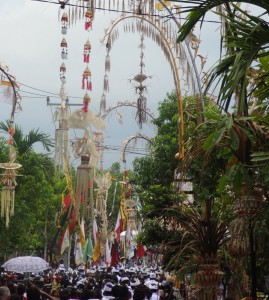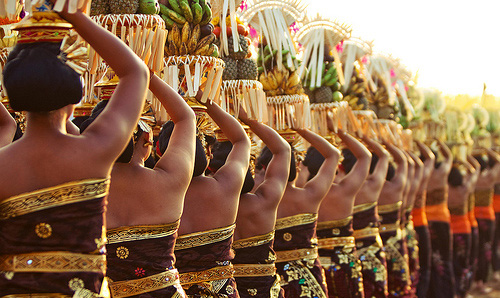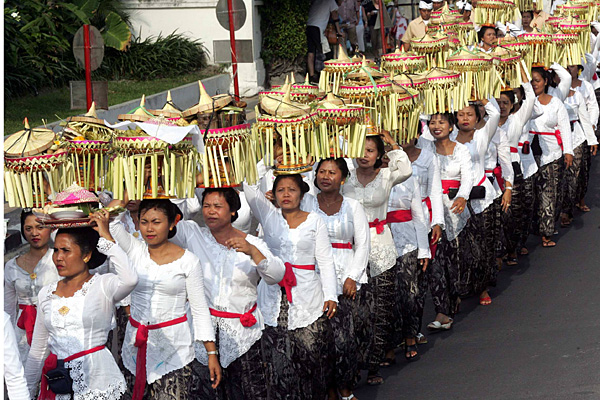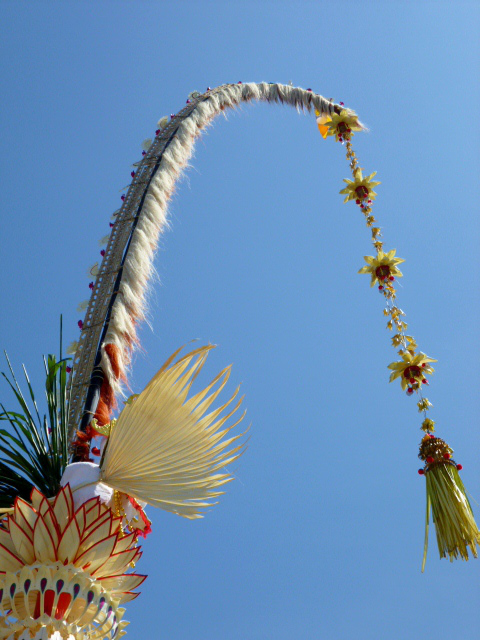 Galungan is a series of Balinese holidays that lasts for between 13 – 16 days. Occurring once during the 210 day Pawukon Calendar, Galungan marks the beginning of the most important recurring religious ceremony celebrated by the Hindu Balinese.
Galungan is a series of Balinese holidays that lasts for between 13 – 16 days. Occurring once during the 210 day Pawukon Calendar, Galungan marks the beginning of the most important recurring religious ceremony celebrated by the Hindu Balinese.
 The word Galungan comes from the old Javanese language, it means “Winning the Battle”. The philosophy behind this sacred ceremony is to give individuals strength to choose between good (Dharma) instead of bad (Adharma). During the Galungan period, not only the Gods but the Ancestral spirits of each family descend to their former homes. They must be suitably entertained and welcomed, and prayers and offerings must be prepared in advance for them. Those families who have ancestors that have not yet been cremated, but are still buried in the village cemetery, must make offerings at the graves.
The word Galungan comes from the old Javanese language, it means “Winning the Battle”. The philosophy behind this sacred ceremony is to give individuals strength to choose between good (Dharma) instead of bad (Adharma). During the Galungan period, not only the Gods but the Ancestral spirits of each family descend to their former homes. They must be suitably entertained and welcomed, and prayers and offerings must be prepared in advance for them. Those families who have ancestors that have not yet been cremated, but are still buried in the village cemetery, must make offerings at the graves.
The actual Galungan season is observed as follows:
- Sugihan Jawa: 6 days before Galungan, this ceremony is to purify the earth and environment outside the human body.
- Sugihan Bali: 5 days before Galungan, this ceremony is to purify the mind, soul and body of each person as well as to build up the strength of the mind.
- Penyajaan Galungan: 2 days before Galungan, for Hindu’s that practice yoga and Samadhi they are worshipping to all Gods.
- Penampahan Galungan: 1 day before, this is called “Victory Day”. The day when we beat the “Butha Galungan” (giant demons). Usually, a pig is killed for offering symbolizing the killing of the beastly nature within our minds.
- Galungan: This is the day the Gods and Ancestors descend from the heavens.
- Manis Galungan: The day after Galungan, people celebrate and enjoy all the glory. People visit family members or go to places of pleasure with beautiful scenery.
- Kuningan: 7 – 10 days after Galungan, it’s the day when the Gods and ancestors go back to the heavens. The ceremony must take place in the morning because by mid-day all gods will have already departed.

Galungan always falls on a Wednesday and most Balinese will begin their Galungan ‘holiday’ the day before with Hindu families busily preparing the offerings and cooking for the next day. While the women of the household are busy creating the beautifully woven Banten (offerings made from young coconut fronds), the men of the village usually join with their neighbors to slaughter the pig. Then the finely diced pork is mashed to a pulp with a grinding stone, and molded onto sate sticks that have been already prepared by whittling small sticks of bamboo. Delicate combinations of various vegetables, herbs and spices are also prepared by the men to make up a selection of ‘lawar’ dishes. While much of this cooking is for use in the offerings to be made at the family temple, it is also used for a series of satisfying feasts.
 The men have another job to do as well, to prepare a long bamboo pole or Penjor made to decorate the entrance to every Balinese Hindu compound. The aim of erecting Penjor’s at Galungan time is to show devotion to Hyang Giri Pati, the God of the Mountain. Mountains with deep forests hold water which flows into rivers. This then fulfills the water needs (Irrigation and drinking water) for the Island of Bali. By late Tuesday afternoon all over Bali the visitor can see these decorative poles creating a very festive and colorful atmosphere throughout Bali.
The men have another job to do as well, to prepare a long bamboo pole or Penjor made to decorate the entrance to every Balinese Hindu compound. The aim of erecting Penjor’s at Galungan time is to show devotion to Hyang Giri Pati, the God of the Mountain. Mountains with deep forests hold water which flows into rivers. This then fulfills the water needs (Irrigation and drinking water) for the Island of Bali. By late Tuesday afternoon all over Bali the visitor can see these decorative poles creating a very festive and colorful atmosphere throughout Bali.
The actual Galungan and Kuningan days are a time for prayer, family get together’s and offerings. Throughout these day’s the local temples are crowded with people coming and going, bringing the offerings that have so carefully been prepared. In respect to our Hindu employees, the Teak Bali corporate offices are closed during these 2 major holidays.

Hello Danny,
I share your love of the Balinese people and culture. I was fortunate enough to experience Eka Dasa in 1979 at the mother temple, Besakhi. That experience changed my life, forever.
Kindest regards,
Nina